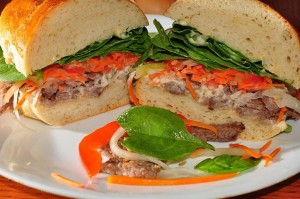Guest Blogger
( This past week the Banh Shop in Dallas, Texas removed a five-pointed red star from its logo after an uproar from the Vietnamese American community. This is one man’s take on what happened).
The star, and communism, are disliked or hated by the Vietnamese American community, especially the elders, because of the Vietnam War, and because they were basically expelled by the Communists. The standing of people in Vietnam is secondary, and I’ll explain below.
The Banh Shop is a pilot of a fast food shop being created by Yum brands, which also owns KFC and Taco Bell, so this is one of the large transnational fast food enterprises. They are interested in banh mi mainly because it’s a big trend in the USA. There’s at least one big sandwich chain out of San Jose (a big Vietnamese community). It’s also a trend in the hipster communities.
So, Yum isn’t really referencing Vietnamese culture as much as riding a trend created by Vietnamese Americans. Or it should be – but this is where racism intervenes. Racism makes Asians perpetual foreigners. So, when they started to do the branding for Banh Shop, they probably thought about what Vietnam represents… to mainstream/White America.
To America, it represents a war that was lost to the Communists, but also a new site of capitalism and business. Thus, the red star and the retro typeface.
Sure, the Vietnamese American community is opposing Vietnam. They oppose the fact that the North won and instituted Communism. That’s why I said the conflict is about them, and not about Vietnam in general.
If Yum had been more astute, they would have copied some of the ideas from Vietnamese American shops. They make all these references to France and the days of colonial Indochina. Some places have a picture of the Eiffel Tower. Others have ornate “French” style decor, at least in parts. They call the bread baguettes (and they are). The point being: the sandwich is a Vietnamese hybrid artifact that was created through colonialism.
I don’t really know what “Frenchness” signifies to Vietnamese Americans, but it it’s interesting to consider.
Instead of exploring the local communities, Yum went the “Taco Bell” route of pretending something that’s pretty American is really “foreign”.
Taco Bell is a hybrid food, not just in the current weird incarnation, but even originally. The tacos with hamburger meat, the bean and cheese burritos, enchiladas (they had a thing called enchiritos), and the tostada are both Mexican and Southern Californian. I’d say more SoCal than Mexican.
They aren’t a fake “white guy invented this” food either. These old Taco Bell menu items are similar to what Mexican American restaurants sold in the 1950s at “taco shops”. It wasn’t really exotic food either – McDonalds and Jack in the Box and dozens of other fast food restaurants of the 50s sold this type of Mexican food. (And they still do, today.)
As Taco Bell got corporatized, the branding became more exotic and foreign. The branding erased the legitimate cuisine of an American community.
So, the fact that Yum is ignoring the Vietnamese American community, and using symbols that non-Vietnamese associate with Vietnam, is a problem because it erases the presence of Vietnamese Americans. It’s not really about Vietnam. It’s about corporate racism in America, against an American community.
(note from the editor: The commentary above was posted by John Kawakami on Facebook and reposted with his permission.)


